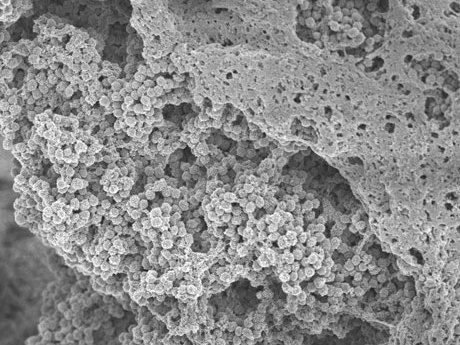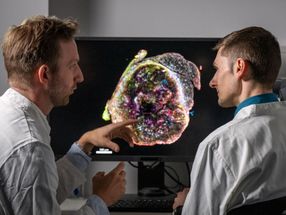New technique could prevent dangerous biofilms on catheters
biofilms frequently coat the surfaces of catheters, and of various medical implants and prostheses, where they can cause life-threatening infections. New research at the Sahlgrenska Academy show that coating implants with a certain ”activator” can prevent Staphylococcus aureus, the leading cause of hospital-acquired infections, from forming biofilms.

Staphylococcus aureus bacteria forming biofilm - New technique could prevent dangerous biofilms on catheters
University of Gothenburg
Biofilms are mats of bacteria similar to the plaque that grows on teeth. Biofilms frequently coat the surfaces of catheters, and of various medical implants and prostheses, where they can threaten lives or lead to failure of the implants.
Antibiotics are impotent against biofilms. Now Gothenburg researchers Jakub Kwiecinski, Tao Jin and collaborators show that coating implants with “tissue plasminogen activator” can prevent Staphylococcus aureus, the leading cause of hospital-acquired infections, from forming biofilms.
Hijacks the system
A growing biofilm requires anchoring, and in earlier research, this team, led by Jin, an Associate Professor of Rheumatology and Inflammation Research, the University of Gothenburg, Gothenburg, Sweden, had discovered that S. aureus hijacks the human clotting system to create a scaffold of micro-clots to support the growing biofilm.
“We hypothesized that if we forced the human body to start dissolving those clots, we could prevent the biofilm from developing,” said Kwiecinski, a post-doctoral researcher in Jin’s laboratory.
Clot-dissolving protein
To encouraging the clot-busting, the investigators coated the surfaces with tissue plasminogen activator (tPA), which activates the clot-dissolving protein, plasminogen.
“This deprives S. aureus of a scaffold for biofilm formation and prevents infection,” said Kwiecinski. After performing the research under laboratory conditions, they confirmed that it works by coating catheters that they then implanted into laboratory mice.
Looking beyond bacteria
A key to the team’s success was their decision to look beyond the bacteria, the stopping place for most previous research, to the human body’s involvement in the infections, said Kwiecinski. The clot-busting, he said, could be applied to biofilms of pathogens other than S. aureus.
Original publication
Most read news
Original publication
Jakub Kwiecinski, Manli Na, Anders Jarneborn, Gunnar Jacobsson, Marijke Peetermans, Peter Verhamme and Tao Jin; "Tissue plasminogen activator coating on surface of implants reduces Staphylococcus aureus biofilm formation"; Applied and Environmental Microbiology; 2015
Topics
Organizations
Other news from the department science

Get the life science industry in your inbox
From now on, don't miss a thing: Our newsletter for biotechnology, pharma and life sciences brings you up to date every Tuesday and Thursday. The latest industry news, product highlights and innovations - compact and easy to understand in your inbox. Researched by us so you don't have to.

























































